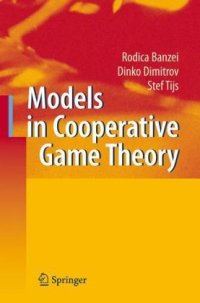
Ebook: Models in cooperative game theory
- Genre: Economy // Mathematical Economics
- Tags: Game Theory/Mathematical Methods, Game Theory Economics Social and Behav. Sciences, Operations Research/Decision Theory, Microeconomics, Operations Research Mathematical Programming
- Year: 2008
- Publisher: Springer-Verlag Berlin Heidelberg
- Edition: 2
- Language: English
- pdf
Cooperative game theory is a booming research area with many new developments in the last few years. So, our main purpose when prep- ing the second edition was to incorporate as much of these new dev- opments as possible without changing the structure of the book. First, this o?ered us the opportunity to enhance and expand the treatment of traditional cooperative games, called here crisp games, and, especially, that of multi-choice games, in the idea to make the three parts of the monograph more balanced. Second, we have used the opportunity of a secondeditiontoupdateandenlargethelistofreferencesregardingthe threemodels of cooperative games. Finally, we have bene?ted fromthis opportunity by removing typos and a few less important results from the ?rst edition of the book, and by slightly polishing the English style and the punctuation, for the sake of consistency along the monograph. The main changes are: (1) Chapter 3 contains an additional section, Section 3. 3, on the - erage lexicographic value, which is a recent one-point solution concept de?ned on the class of balanced crisp games. (2) Chapter 4 is new. It o?ers a brief overview on solution c- cepts for crisp games from the point of view of egalitarian criteria, and presents in Section 4. 2 a recent set-valued solution concept based on egalitarian considerations, namely the equal split-o? set. (3)Chapter5isbasicallyanenlargedversionofChapter4ofthe?rst edition because Section 5. 4 dealing with the relation between convex games and clan games with crisp coalitions is new.
This book investigates models in cooperative game theory in which the players have the possibility to cooperate partially. In a crisp game the agents are either fully involved or not involved at all in cooperation with some other agents, while in a fuzzy game players are allowed to cooperate with infinite many different participation levels, varying from non-cooperation to full cooperation. A multi-choice game describes the intermediate case in which each player may have a fixed number of activity levels. Different set and one-point solution concepts for these games are presented. The properties of these solution concepts and their interrelations on several classes of crisp, fuzzy, and multi-choice games are studied. Applications of the investigated models to many economic situations are indicated as well. The second edition is highly enlarged and contains new results and additional sections in the different chapters as well as one new chapter.